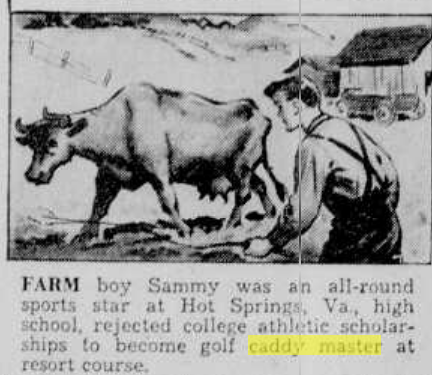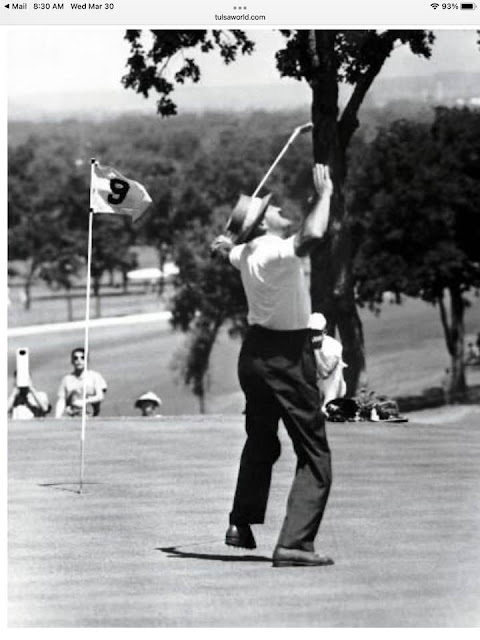1941-1946
Johnie F. Stapp, The War Years
1941 notes from personal scrapbook
Before the war began my father, Johnie Stapp, enlisted. He was stationed at Camp Robinson, Little Rock, Arkansas. The only story I ever remember from him was when they learned to march through the swamps of S.E. Arkansas and Louisiana. He told me that it honestly scared him to pieces, because he could just imagine all of the snakes in the trees. Then one day a snake fell on one of his companions. Although it did not kill him, nor dad, I've never forgotten that picture he described. (No wonder I tell stories.)
"Tough Soldiers Balk at Wet Links"
The Division golf tournament opened last Sunday as six soldiers waded through rain soaked links in three 18-hole matches.... Pvt. John Stapp, Medical Detachment, 137th Infantry, defeated Pvt. Pat Shelton, Headquarters Company, 137th, two and one at Fair Park.
Rain forced postponement of other first round matches. Twenty-two golfers are entered in the championship tournament. All matches are being played on Little Rock links.
1941 August 12 "Golf Champion"
Pvt. John Stapp of Wichita, a member of the 137th Infantry, today was crowned golf champion of the 35th division. Stapp won the title in yesterday's championship flight when he defeated Pvt. Richard Logger of St. Louis, 4 and 3. Logger is a member of the 138 Infantry.
1942 February 20 "Wichitan in the News"
Johnie Stapp formerly of 35th Infantry division made a hole-in-one at Fair Park Municipal Course in Little Rock. He played with Lloyd and Bill DeBacker.
1943 January
Lieut. John Stapp is visiting his parents. Stapp, formerly stationed at Aberdeen Proving Ground, Maryland will be stationed at Camp Santa Anita, in California as a staff and faculty. Stapp received his commission on September 26, 1942, and met his future wife, my mother, Helen.
Lt.Stapp shot a 73, three over par 70, to win Low Gross for officers in the Camp Santa Anita Cup. Stapp received a 14" engraved cup.
1943 April 16
In the officers and non-commissioned officers event, the team of Lt. Stapp and Pvt. Danner snared the golf titles. "Salute the winners, the Turfbirds", of the Camp Santa Anita golf tournament. You might as well for one of them raises a highball anyway you look at it." Stapp's score of 73,72,71,73=289 is a strong show.
1943 August 10 L.A. Times
Lt. Stapp takes the coveted Arcadia Crown. The first man to win the Arcadia City Championship at Annandale Country club, by shooting a 69.
1943 August 20 by Jack Curnow
"Snead's Navy Golfers Play Army Team"
Sam Snead, who needs no introduction to the golfing world will head a contingent of blue-jackets from San Diego Navy Base today against a soldier outfit from Santa Anita Ordinance Camp in a 10-man play over the sporty county-owned Santa Anita links in Arcadia.
Backing up Slamming Sammy will be an Alhambra product Bill Nary, the long-hitting ex-Rancho Santa Fe pro who joined the Navy several weeks ago....
Heading the Ordinance golfers will be Lt. Johnie Stapp, ex-Kansas golf pro who has been right on his stick lately. He'll have the team of Col.F.G.Bryan, Capt E. H. Christensen.......
The match starts at 2 pm and is open to the public. Off the early dope, the blue-jackets figure to nudge the soldiers.
1943 October L.A. Times by Mel Gallagher
Lloyd Mangrum, one-time Texas caddy who develop into one of the leading golf professionals of the nation, arrived home last week from his summer links tour prepared to enter the Southern California Open October 15,16, 17.
The stylish clubbing Mangrum, a mainstay of Walter Hagen's Ryder Cup team for the past two years will be a strong favorite for this Arcadia tournament title. He has shown a liking for the stretching Santa Anita par 70 layout, having spread-eagled an open field there two years ago. ....
1943 October 12 L.A. Times by Jack Curnow
"Mangrum-Bassler Card 63s in Pro-Amateur"
Harry Bassler, Fox Hill pro, and Lloyd Mangrum of Monterey Park, traveling pro, served warning on the large field entered in this weekend's Southern California Open, when they fired identical 68's in the pro-am tourney. Three teams tied for third place money with 65's; Pro Eddie Hobit and Frank Horton, 32-33; Lieut. Johnie Stapp and Joe Mabley 34-31; and Ray Haines, assistant pro to Ellsworth Vines at Southern Country club and Fred Clark, Jr. 32-33.
1943 October 14 L.A. Times by Jack Curnow
"Southland Open Takes Tee Today"
The big guns start firing today in the Southern California Open at Santa Anita Golf Club in Arcadia. The 72-hole medal play affair; which has lured a big field of local favorites and many newcomers now here in the war work and military service, gets under way with 18 holes of play. ....
At the halfway mark Joe Kirkwood, Jr. lead the field with 70-71....Lieut. John Stapp with a 74-72;
**At this point in Santa Anita dad has become friends with Sammy Snead, Lloyd Mangrum, and Johnny Bulla, George Fazio, Byron Nelson, Ed Dudley (who was MGCC's first golf pro). Ray Beardon, head pro at Santa Anita and Ellsworth Vines, pro at Southern California Country club. He and mother often shared stories of Elly Vines, who had been the national tennis champion before turning golf pro.
*Note: Johnie spent the remainder of the war years in the Pacific Islands. After the war he remained in Japan for several months, helping with the closure of the war and communications with the Japanese. During that time he became close friends with Dr. Seturo, a Japanese doctor at the Tuberculosis Sanatorium.
I followed up on the doctor he befriended after the war. This is a clip from my story. Dr. Seturo's niece writes:
"Your father's friend, Dr Seturo, was a very talented person. After graduating from medical school in Japan, he was studying at the University of Bern in Switzerland.
His son, Mitsuko's father, was also a doctor. He went to North China as a medical doctor. At the end of the war he was interned in Siberia and missing forever It was a really sad story."
To read more of this World War II story please click on this link Touching Lives
 | |
| Helen Stapp, Arcadia, Ca. 1946 |
1946 May 25
My mother, Helen Weaver, who met her future husband, Johnie while he was home on leave in Wichita, Ks., married him on May 25 at the Little Church of the West in Las Vegas. Their first daughter, Letty, was born December 26, 1947.
Johnie returned from the war and began working at the Santa Anita Golf Course as a teaching pro. He actively taught golf lessons to students in the various college campuses around Santa Anita. During this time he met many of the Hollywood stars who played the Santa Anita course and bet on the races at the Santa Anita Racetrack Park.
It was through his golf at Santa Anita that he met Bing Crosby and Johnny Weissmueller. In January 1947 he attended the Bing Crosby Tournament being held at Pebble Beach. Knowing this from my father's stories I researched to the best of my abilities any kind of list or story that might show when he played. (If newspapers are not online then the records remain on microfilm or microfiche in area libraries.) I did not find any list of players, but I thoroughly enjoyed reading articles from all over the United States telling tales of the Clambake. I also discovered that in the late 1940's Crosby Tournament was so popular that it was carried on the radio.
 |
| Picture of Johnny Weismuller, Tarzan, from Stapp family photos. |
From 1937--1942 Bing Crosby held his tournaments at Rancho Santa Fe near San Diego. After the war in 1947 Crosby moved his tournament for more money and larger gatherings to Pebble Beach, California. The nickname "Clambake" came from the early days when Bing gathered the players on the beach for an authentic "clambake" with food, entertainment, and drinks for everyone.
Bing Crosby Tournament History
**I had hoped to find my father's connection to George Coleman, Jr. through the stories on Bing Crosby's Tournament. Johnie would have been invited to the clambake by Crosby since he knew him personally from his work at Santa Anita. I know that he attended the tournament at least one more time before moving to Miami. He already knew George Coleman, Jr. before moving to Miami. So I am guessing they met in California.
In
our first year in Miami (1954) dad bought a dark green 1952 Oldsmobile
from George Coleman, Jr. It was a supped up engine, and became a race car. We traveled
to California in that car when I was too young to remember anything but
looking out the car window and seeing the road drop off in a cliff. I also experienced dirt track racing in that Olds.
This same car 52 Oldsmobile photo became a well known speedster before Johnie bought the Muntz from Lou Newell in 1959 or 1960. The speedster Olds took Johnie and Doc Robert Baron to California in a single day or less, so the story goes. Of course, the same story can be told about Johnie and Doc Jackson traveling to California in 24 hours. I do not recall which Pro-Am's they played in but it seemed to be fun and profitable for dad's teams.










.JPG)
.JPG)
